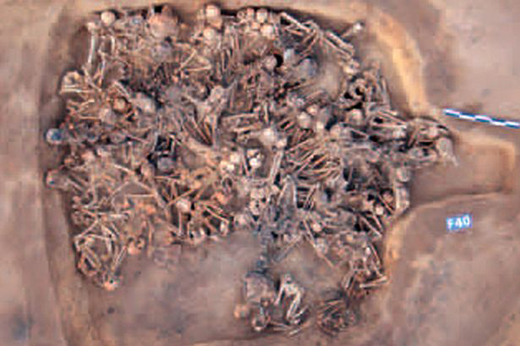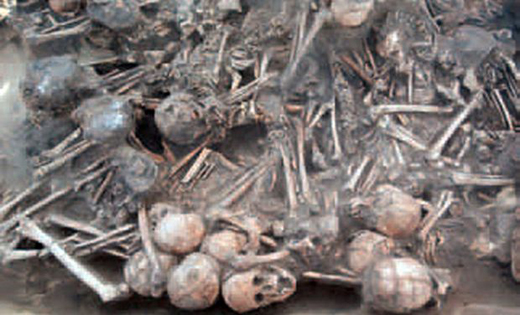Grisly remains of 97 bodies found stuffed into 5,000 year-old ’House of Horrors’
Grisly remains of 97 bodies found stuffed into 5,000 year-old ’House of Horrors’
Mangalore Today News Network
Aug 02, 2015: The gruesome remains of 97 human bodies have been found stuffed haphazardly inside the charred wreckage of a house.
The grisly discovery was made by scientists excavating a 5,000-year-old village in northeast China.
 Haphazard: The bodies were crammed into the house, which later burnt down
Haphazard: The bodies were crammed into the house, which later burnt down
Scientists said the bodies of teenagers, young adults and middle aged men and women were packed into the tiny building, which was smaller than a modern-day squash court.
Archaeologists who studied the remains said they had been wiped out by a "prehistoric disaster," such as an epidemic, and had been stacked inside the house instead of being buried.
The way the bodies were messily scattered suggests they were dying faster than the survivors could deal with their corpses.
The site, whose modern-day name is "Hamin Mangha," dates back to a time before writing was used in the area, when people lived in relatively small settlements, growing crops and hunting for food.
The village contains the remains of pottery, grinding instruments, arrows and spearheads, providing information on their way of life.
Epidemic: It is believed the 97 people were wiped out by a prehistoric disaster
"Hamin Mangha site is the largest and best-preserved prehistoric settlement site found to date in northeast China," a team of archaeologists wrote in a translated report published in the most recent edition of the journal Chinese Archaeology.
Between April and November 2011, the researchers found the foundations of 29 houses, most of which are simple one-room structures containing a hearth and doorway.
The house with the bodies, dubbed "F40," was just 210 square feet.
"On the floor, numerous human skeletons are scattered in a disorderly way," the archaeologists wrote.
"The skeletons in the northwest are relatively complete, while those in the east often [have] only skulls, with limb bones scarcely remaining," the archaeologists wrote.
"But in the south, limb bones were discovered in a mess, forming two or three layers."
At some point the structure burnt down. The fire likely caused wooden beams of the roof to collapse, leaving parts of skulls and limb bones not only charred but also deformed in some way, the archaeologists wrote.
The remains were never buried and were left behind for archaeologists to discover 5,000 years later.
An anthropological team at Jilin University in China is studying the prehistoric remains, trying to determine what happened to these people.
The team has published a second study, in Chinese, in the Jilin University Journal – Social Sciences edition, on their finds.
The researchers found the people in that house died as the result of a "prehistoric disaster" that resulted in dead bodies being stuffed into the house.
The dead came in faster than they could be buried.
"The human bone accumulation in F40 was formed because ancient humans put remains into the house successively and stacked centrally," wrote team leaders Ya Wei Zhou and Hong Zhu in the study.
The team found that about half of the individuals were between 19 and 35 years of age.
No remains of older adults were found.
Courtesy: London Mirror
- Karnataka Lok Sabha election: Voting timings, Key candidates and phase 2 polling constituencies
- Sullia: Rider dies in bike-jeep collision
- Mangaluru: Mustering process held ahead of LS polls
- Mangaluru: BJP accuses Congress of circulating fake pamphlet
- Over 2.88 crore voters in Karnataka to cast their franchise on April 26
- Communally sensitive DK dist was a narrative created by few: Captain Brijesh Chowta
- BJP protests against Congress government’s ‘anti-people’ policies
- Renowned Yakshagana Bhagavatha Subrahmanya Dhareshwar no more
- People must support Congress to develop DK as land of harmony: Padmaraj
- Railways to operate special trains to clear extra rush during election day
- BJP, Congress candidates end campaign by conducting roadshows in Mangaluru
- There is no Modi wave in DK: Harish Kumar
- Railways to operate election special trains from Bengaluru to Mangaluru, Kundapura
- World Malaria Day 2024: Know theme, significance and prevention tips
- Man hangs from moving car’s door with plastic wrap, video goes viral
- Video of dog twinning with little girl in school uniform is too cute to miss, Watch
- Earth Day 2024: History, theme and 10 activities that can help protect our planet!
- Woman’s Jal Tarang rendition of Aigiri Nandini goes viral, Watch
- World Liver Day 2024: These factors might worsen your liver health
- World Heritage Day 2024: Theme, history, significance, and top 5 heritage sites in India
- How science will get Sun to kiss Ram Lalla’s forehead on Ram Navami
- Artist’s sweet gesture towards waiter impresses the Internet, Watch
- Children addicted to video games, smartphones at risk of Psychosis: Study
- This story of an ailing elephant and her calf will move you to tears
- Listen to your body: 5 types of pain signalling heart issues
- Eid ul-Fitr: Why it is celebrated and other things to know
- Educational, financial institution shut due to Lok Sabha election 2024 in these areas
- Supreme Court verdict tomorrow on 100% EVM-VVPAT verification
- 6 Dead as massive fire engulfs Patna hotel, over 50 feared trapped, watch
- Horlicks, Boost drop ’Health’ label, rebranded as "Functional, Nutritional drink"
- Not One Vote: Mamata Banerjee’s big message after 26,000 teachers lose jobs
- On complaints against PM Modi, Rahul Gandhi, poll body’s notice to parties
- RBI plans curbs on suspect bank accounts to fight cyber fraud: Report
- Sunita Kejriwal to lead AAP’s Lok Sabha campaign in Delhi, hold roadshows
- ’Desperation born from fear of defeat’: Siddaramaiah slams Modi, defends 4% Muslim quota
- ED challenges Arvind Kejriwal’s plea in Supreme Court: ’173 phones destroyed’
- 103-year-old CSK fan flaunts love for cricket, wishes to meet MS Dhoni
- How an Indian heart saved a Pakistani teen’s life
- CITY INFORMATION
- TRAVEL
- TOURIST INFORMATION
- HEALTH CARE
- MISCELLANEOUS




 Write Comment
Write Comment E-Mail
E-Mail Facebook
Facebook Twitter
Twitter  Print
Print 

